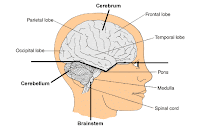
Brain Encephalopathy
Toxic what? Encephalopathy (en sef al ah' pathy) simply means something wrong with the brain. and toxic encephalopathy means a brain that is toxic or poisoned and does not function properly because of some environmental toxin or chemical.
Toxic encephalopathy is just the medical word for the under recognized, under-diagnosed brain fog. This classic symptom is often erroneously chalked up to normal aging, stress, poor memory, or a bad personality. Many people do not know that there is a cause and a cure for brain fog or toxic encephalopathy. But unfortunately, many do not know that they even have it, for there is a silent epidemic of toxic encephalopathy.
What are the symptoms of brain fog? Dopey, dizzy, spacy, can't think clearly, "feel like there's a bag over my head," can't concentrate, poor memory, depressed for no reason, fatigue for no reason, or unexplained mood swings out of proportion to the trigger.
And the causes of brain fog? For many they are the everyday chemicals found in furnishings, bedding, building construction materials, cosmetics, toiletries, traffic exhaust, office supplies, pesticides, and much more." [and the toxins in wood smoke from heating with wood and burning wood and charcoal and forest fires, burn barrels and field burning. Ed. Burning Issues.
It might seem like a flight into fantasy to think that seemingly harmless everyday chemicals can affect the brain. But actually it is the number one target organ affected.
For these chemicals can diffuse through the nose and lung membranes right into the blood stream and brain rather rapidly. And once there, if the person is low in any vitamins or minerals in the pathways to rapidly detoxify the chemical, the the undetoxified amount back up and starts to do its damage, producing these bizarre symptoms.
One danger lies in the fact that this erratic function of the brain can lead to accidents. For example, the inhalation of exhaust fumes has been the cause of some auto accidents and pilot error. Not knowing you have brain fog considerably jeopardizes personal relationships too, especially when it suddenly provokes mood swings. Or it can cause a child to be erroneously labeled as learning disabled or attention deficit disorder or poor achiever. It can lead to poor work performance, depression and the need for antidepressants, and is in part responsible for our current Prozac epidemic. And it can even lead to criminal acts.
Physician who are not knowledgeable in environmental medicine will vehemently deny the existence of brain fog or toxic encephalopathy, or erroneously refer the patient for psychiatric care.
Thanks to a recent article by Dr. Edward L. Baker, Director of Public Health Practice Program office at the Centers for Disease Control and Prevention in Atlanta, Georgia, we understand that it is not a figment of our imaginations. ..(Baker EL, A Review of Recent Research on Health Effects of Human Occupational Exposure to Organic Solvents. A Critical Review, Journal of Occupational Medicine 36:10 1079-1092 Oct. 1994) Wood smoke has organic solvents ( or PAH). Ed.
To paraphrase physical effects: " When the brain is unable to detoxify some of these chemicals, it actually manufactures chloral hydrate in the brain, better known as the old "Mickey Finn" or knock-out symptoms."
Sherry A Rogers, M.D. a Diplomat of the American Board of Family Practice, a Fellow of the American College of Allergy and Immunology and a Diplomat of the American Academy of Environmental Medicine, has been in private practice for over 26 years.
She is a lecturer of yearly original scientific material, as well as advanced courses for physicians. She was the keynote speaker for the international symposium Indoor Air Quality 86 in which she described the office method for testing chemical sensitivities.
She developed the Formaldehyde Spot Test and published her mold research in three volumes of the ANNALS Of ALLERGY. She has published chemical testing methods in the National Institutes of Health journal, ENVIRONMENTAL HEALTH PERSPECTIVES. She has published 17 scientific articles, 10 books, and was the environmental medicine editor for INTERNAL MEDICINE WORLD REPORT.
She has lectured throughout China, Sweden, England, Canada, and Europe, as well as the United States in indoor air symposia to physicians and the public. She has appeared on numerous television and radio programs and writes monthly articles for health magazines, plus her own and other newsletters covering all aspects of environmental illness.
Man has neglected one fundamental biological rule; to check and see if the organism is adapting to its new environment. She says we are the first generation to be exposed to such an unprecedented number of chemicals. The work of detoxifying these causes serious deficiencies. This maladaptation in turn has resulted in chronic disease. But disease is not a drug deficiency. The common goal of her current research projects is that of helping people adapt naturally to the 21 st century and reverse chronic disease.

























